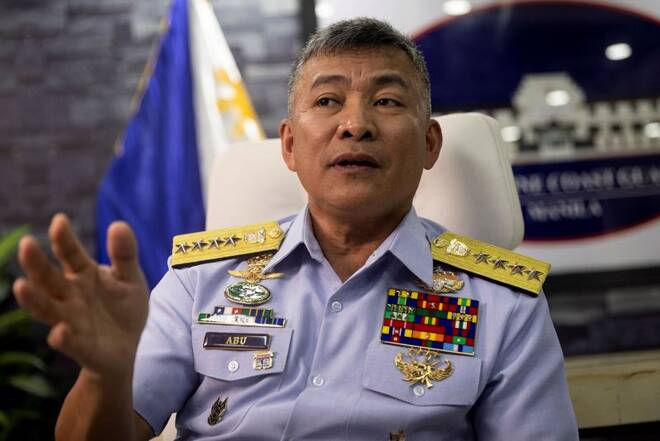Advertisement
Advertisement
Philippines coast guard chief says boosts South China Sea presence
By:
By Karen Lema MANILA (Reuters) - The Philippine Coast Guard has stepped up its presence in the disputed South China Sea by deploying additional vessels and conducting more sorties and overflights to protect maritime territory and the country's fishermen, its chief said on Monday.
By Karen Lema
MANILA (Reuters) – The Philippine Coast Guard has stepped up its presence in the disputed South China Sea by deploying additional vessels and conducting more sorties and overflights to protect maritime territory and the country’s fishermen, its chief said on Monday.
Beijing’s sweeping claims of sovereignty over the waterway have drawn repeated complaints from Manila, which has ramped up its rhetoric against reported Chinese construction activities and the “swarming” of Chinese vessels in the resource-rich waterway.
“We’re making sure that the presence of coast guard vessels is felt by the fishermen in the area,” Admiral Artemio Abu, Commandant of the Philippines Coast Guard (PCG), said in an interview.
Last month, PCG said it received a report that a Filipino fishing boat was forced by China’s coast guard to leave the Second Thomas Shoal, known locally as Ayungin Shoal, which lies within the country’s exclusive economic zone.
China’s embassy in Manila did not respond when asked for comment about the incident at the time. China claims the reef as its territory.
“We are strengthening our presence,” said Abu. The PCG chief was appointed by former President Rodrigo Duterte, who pursued warmer ties with Beijing, setting aside a longstanding territorial spat, in exchange for investment.
“At a moment’s notice, the coast guard vessels we will be there because they are exclusively and primarily dedicated for that purpose,” said Abu.
The 26,000-strong coast guard has 25 primary ships that can be used for deployment and patrols.
Beijing claims much of the South China Sea, where about $3 trillion in ship-borne trade passes annually, with the area becoming a flashpoint for Chinese and U.S. tensions around naval operations.
President Ferdinand Marcos Jr, who succeeded Duterte, has vowed he would not lose an inch of territory to any foreign power, drawing cheers from advocates of a 2016 arbitral ruling invalidating China’s claims in the South China Sea.
Since 2002, the Philippines has filed 200 diplomatic notes and protests against China’s actions in the South China Sea.
Last month, Marcos met Chinese President Xi Jinping and the leaders reaffirmed that their countries would respect each other’s sovereignty and territorial integrity.
But Marcos last week approved a U.S. request for expanded access to Philippine military bases, as Washington seeks to extend its security options as part of efforts to deter what it perceives as China’s aggressive policies in the region.
The Pentagon also said separately the United States and the Philippines had “agreed to restart joint maritime patrols in the South China Sea to help address these challenges.”
PCG’s Abu said the coast guard’s acquisition of more advanced vessels, including a 97-metre (318.24-ft) multi-role response vessel last year, had allowed it to increase the number and duration of trips in the South China Sea.
“We can stay there longer, farther and we can we can cover a bigger area now,” said Abu.
(Reporting by Karen Lema; Editing by Ed Davies)
About the Author
Reuterscontributor
Reuters, the news and media division of Thomson Reuters, is the world’s largest international multimedia news provider reaching more than one billion people every day. Reuters provides trusted business, financial, national, and international news to professionals via Thomson Reuters desktops, the world's media organizations, and directly to consumers at Reuters.com and via Reuters TV. Learn more about Thomson Reuters products:
Advertisement
